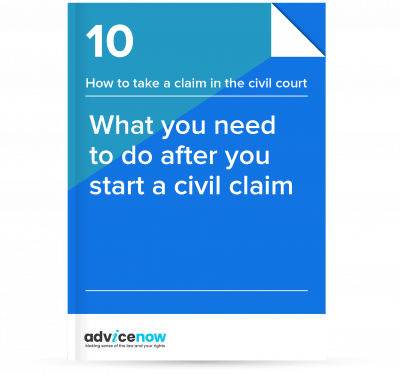‘Directions’ is the court’s word for the list of instructions it gives to both you and the defendant for the practical management of your case. These instructions tell you what you each need to do to get the case ready for the final hearing. Their purpose is to make sure that:
- the court and both sides know everything they are entitled to know about the case before trial,
- both sides know which parts of the case they agree on and which parts they disagree on (the judge will only be making a decision on the parts you disagree on)
- both sides fully understand each other’s case and can prepare their own case focusing on what they disagree about, and
- the court can make arrangements including working out how much time to allow for the trial.
Directions questionnaire
The court sends both you and the defendant a ‘Directions questionnaire’. This asks each of you for information to help the court decide:
- how to deal with the case,
- what directions to make, and
- which track and complexity band to allocate the case to.
Before completing this questionnaire, you and the defendant must contact each other to discuss how far you can agree your answers to it. In particular the court wants you to try and agree the directions you would like it to make.
Whether you can agree them or not, you must send a list of the directions you want the court to make to the court at the same time as returning the questionnaire. (You don’t need to send in this list if the court has provisionally allocated your case to the small claims track.)
When you have filled in the directions questionnaire you must send it back to the court and a copy to the other side within the time limit set by the court. If you don’t comply with the time limit, the court could ‘strike out’ your case - which means stop your case from continuing.
The court considers the answers to the directions questionnaires and decides which track is the right one for your case. The court will send you a notice of allocation. This tells you the judge’s decision.
An order for directions
The court will also send you an ‘order for directions’ (may also be called ‘Directions Order’ or ‘Standard Directions’). This is a list of instructions telling you what tasks to do and the deadline for doing them. The court makes the order for directions based on the information you and the defendant give in your Directions questionnaires.
In particular, an order for directions will deal with:
- Disclosure: this means providing and exchanging relevant information with the other side
- Witness statements: exchanging witness statements with the other side
- Expert’s reports (where they are used)
In most straightforward cases, and whether or not you managed to send the court agreed directions with your Directions questionnaire, the court will make this order without there being a hearing. So, don’t be surprised if an order for directions just turns up in the post.
If this happens to you, the first thing to do is to read the order carefully. If you aren’t certain what some bits mean, get some advice. For further information on finding legal help, see our short guide that explains how to get free legal advice on a civil claim and 'Find a lawyer' section in our Help Directory.
In more complicated cases, the court may arrange a case management conference (often referred to by lawyers and court staff as a ‘CMC’). This is a hearing where the court and the parties decide together how best to run the case. It can take place by video hearing, over the phone, at court, or a ‘hybrid’ meeting, with some people there in person and others joining by video. See more guidance on video hearings.
The court can review case progress at any time and may make more directions or fix a second case management hearing as a result of any review.
The instructions in an order for directions are listed in a particular sequence for a reason. So, for example, typically they will ask you to serve your witness statements after disclosure (the process for showing what evidence you have to support your case). This way each side gets the full picture of the other’s case and sees their evidence before they prepare their witness statements. This enables each side to comment on what they discover from each other's evidence in their statement. So, don’t get ahead of yourself by moving on to the next task until both you and the defendant have completed the previous one.
An example of an order for directions in a fast track case
IN THE GREEN COUNTY COURT Claim No: abc2 BETWEEN [Insert name] Claimant and [Insert name] Defendant _____________ DIRECTIONS _____________ Warning: you must comply with the terms imposed upon you by this order: otherwise your case is liable to be struck out or some other sanction imposed. If you cannot comply you are expected to make formal application to the court before any deadline imposed upon you expires. The claim is allocated to the fast track. The trial window is from 2- 20 June 2022. The estimated length of trial is four hours. Each side shall give standard disclosure to every other side by list. The latest date for delivery of the lists is 29th November 2023. The latest date for service of any request to inspect or for a copy of a document is 6th December 2023. Each party shall serve on every other party the witness statements of all witnesses of fact on whom they intend to rely. There should be simultaneous exchange of such statements no later than 11th January 2023. The claimant may rely on the expert evidence of Mrs Blue, in the form of the report dated 3 May 2021, already served; an updated report to be served no later than 8th February 2022. The time for service of any questions addressed to the expert shall be no later than 14 days after service of the expert’s further report. Any such questions shall be answered within 14 days of service of a question. Pre-trial checklists shall be filed no later than 5th April 2024. The claimant shall lodge an indexed bundle of documents contained in a ring binder and with each page clearly numbered at the court no more than seven days and not less than three days before the start of the trial. Each side must inform the court immediately if the claim is settled, whether or not it is then possible to file a draft consent order to give effect to their agreement. 1 November 2023 District Judge |
What to do if the other side doesn’t obey the order for directions
You are encouraged to sort out interim problems without going back to the court to resolve them. It’s fine to contact the other side or their solicitor (if they have one) outside of the court process. So, you should try informal pressure, for example, phoning or emailing them to remind them what they were supposed to do and by when. Ask them to do it immediately, and explain that if they don’t you will have to go back to court. Tell them when you will do this. If you phone them, follow this up with a letter. Keep a record of every attempt you make to contact the other side in your efforts to resolve any interim problem. If you end up having to go to court you will need this information to show the court.
Be aware!
The court fee for making most types of interim application is, at the time of writing, over £275 so it is better to avoid having to do this if you possibly can.
If this doesn’t work, you may need to apply to the court (see Interim applications - how to ask a civil court to do something) for an order that unless they do the task within a certain number of days (for example, 7 days), the court will not allow them to continue with their defence and/or counter claim. You will often hear this kind of order referred to as an ‘unless’ order. This is because the basic format is always the same; unless you do x task by y date, then z will happen.
If you are the claimant and you don’t do something the order for directions tells you to do, the defendant can take the same action against you.
If you don't apply to vary the order for directions within 14 days of allocation, the court will assume that you will comply with the timetable to be ready for trial. This is why you need to have done all your preparation before you issue proceedings.
You can find the standard directions for cases in the Small Claims Track online.
You can also find the standard directions for cases in the Fast Track or Intermediate Track online.
What do I do if I can’t comply with part of the order for directions?
Courts are quite strict about sticking to time limits, so try and comply with deadlines and keep to the court timetable as much as possible. However, if you can’t comply, don’t ignore the problem because there is usually a solution. First, see if you can resolve the problem informally. Try explaining the problem to the other side and asking them to agree, for example, to an extended time limit for completing a particular task. If you can do this, there is no need to apply for an interim order and you don’t need to tell the court about the new arrangement.
If the other side won’t agree to the change you want to make to the order you can apply to the court (see Interim applications - how to ask a civil court to do something). But you must do this within the deadline – usually only 14 days from when you get the order and you must pay the £275 fee. If you miss the deadline, you may be able to make a late application. The rule in the box below explains how to make an application for a court order. If your application is unsuccessful then you may be ordered to pay what it cost the other side to deal with your application.
There are some dates that only the court can change, for example, the trial date.
If you need to change the trial date The only time there isn’t a fee for an interim application to the court is when the claimant and the defendant agree to apply to the court to postpone the trial date and the court receives their consent application at least 14 days before the date of the hearing. However, once a court has fixed a trial date, it prefers not to change it if at all possible as this is a waste of resources. Courts encourage claimants and defendants to co-operate over any necessary change in the directions timetable, if this will enable the original trial date to go ahead. So, the court may not agree to a postponement even if both of you want it. |

 You may have already shown some or most of your documentary evidence to the other side in an effort to settle (or resolve) your dispute. You may have done this more than once- before you started your claim and afterwards. But there is a stage when the court will usually expect you to show everything in an organised fashion.
You may have already shown some or most of your documentary evidence to the other side in an effort to settle (or resolve) your dispute. You may have done this more than once- before you started your claim and afterwards. But there is a stage when the court will usually expect you to show everything in an organised fashion.  This guide was written and produced by the Advicenow team at Law for Life.
This guide was written and produced by the Advicenow team at Law for Life.